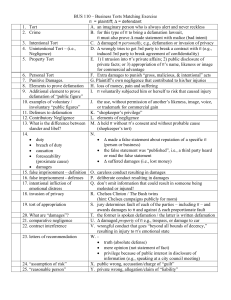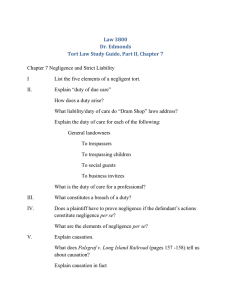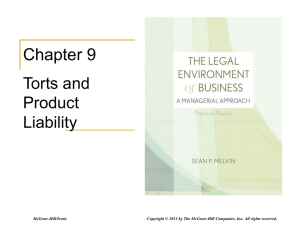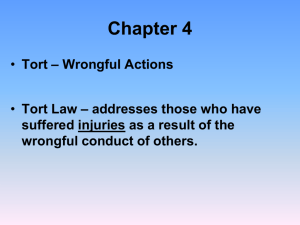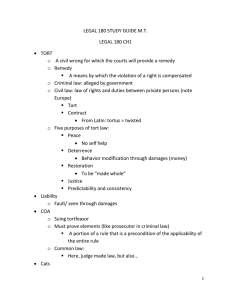Tort Law and Chapter 20
advertisement
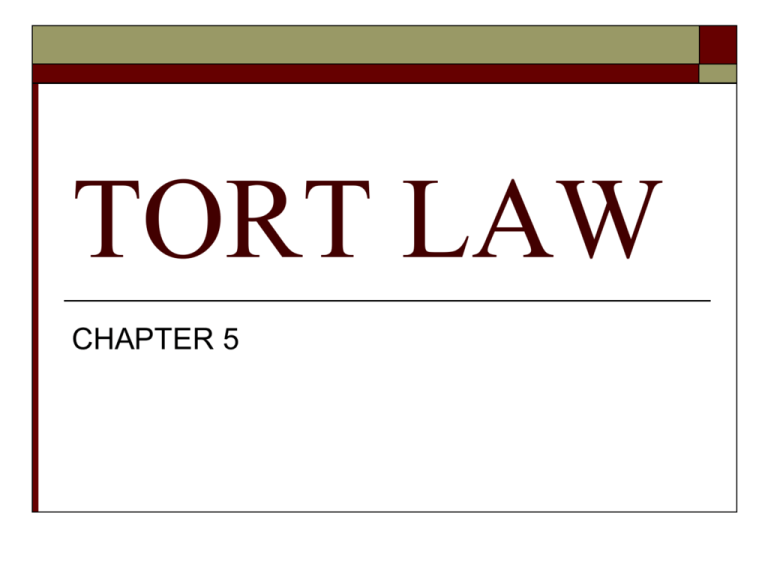
TORT LAW CHAPTER 5 TORT A WRONG AGAINST AN INDIVIDUAL Physical, emotional, property, reputation Respondeat Superior Tortfeasor TORT vs CRIMINAL TORT: Wrong against individual Defendant must compensate for the injury The individual “wronged” must seek a lawsuit CRIMINAL: Wrong against society Defendant sentenced or prescribed a penalty Society prosecutes the offender DUTY As individuals, everyone has a DUTY OF CARE If you violate your obligation, you can be held liable… Violating your Duty Intentionally Neglectfully Theory of strict liability Types of Intentional Tort Assault Battery False Imprisonment Defamation and Disparagement Fraudulent Misrepresentation Invasion of Privacy Infliction of emotional distress Misuse of legal procedure Negligence Failure to exercise the degree of care that a reasonable person would have exercised in the same circumstances Duty of Care Breach of Duty Proximate Cause Actual Harm Defenses to Negligence Cases Contributory Negligence Comparative Negligence Assumption of Risk Contributory vs Comparative Negligence Contributory If injured party’s own negligence contributed to injury, cannot collect …UNLESS Last clear chance Must prove tortfeasor had the last opportunity to avoid injury Comparative Court can assign damages in accordance with degree of fault between the injured and the tortfeasor Assumption of Risk Voluntarily exposing yourself to dangerous situations may prohibit recovery of damages. STRICT LIABILITY For example: Putting on a fireworks display is a very dangerous activity. You may take all precautions, yet something may go wrong and someone gets hurt. You didn’t commit an intentional tort…and you were not negligent in any way…but You are still liable…you accepted responsibility when you undertook the dangerous activity. Product Liability Strict liability standard is imposed in product liability suits if there is an unreasonably dangerous defective product. Liability extends to producer, wholesaler and retailer. Remedies to various torts Monetary damages Economic compensation Non-economic compensation Punitive Damages Injunction Intentional Tort Assault...or…Battery? “Texas Rangers relief pitcher Frank Francisco was arrested for hitting two spectators with a chair, breaking the nose of one, during Monday’s game in Oakland, Calif.” Source: IBD, Wednesday, September 15, 2004 BATTERY – THE CHAIR IS AN EXTENSION OF FRANCISCO False Imprisonment…? The security guard at Wal-Mart stops you as you are ready to exit the store and asks you to step into the manager’s office as he believes you have shoplifted. The guard asked you some questions about the contents of your bag, keeps you there for 20 minutes with the door closed, then calls the police to report that you have shoplifted. You remain in the office for a few minutes until the police arrive. No, this is not false imprisonment Defamation Slander Libel Malice component—ill intent and harm resulting Privileged statements not subject of defamation Pubic figures require higher standard of actual malice What do you think…defamation? A 1983 issue of Hustler Magazine contained a parody advertisement portraying TV Evangelist Jerry Falwell as a drunken, incestuous hypocrite. The ad contained a disclaimer “ad parody – not to be taken seriously”. Falwell sued for libel (and inflicting emotional distress). Did he win? Court ruled that although the statements were false, they were not libelous since Falwell was a public figure and there was no proof of actual malice. Defamation and Disparagement Any false statement communicated to a 3rd party that injures the party’s name or reputation (defamation) or quality of property or product/legal ownership (disparagement) Fraudulent Misrepresentation False statements or actions that someone else depends on to make a decision that prove to be harmful. Invasion of privacy … ? Ann works as a nurse at a clinic and reads the medical record of a fellow nurse, Karen and discovers that Karen was in the hospital suffering from a serious illness. Ann spreads the word to her fellow coworkers and she takes up a collection to buy flowers for Karen. Karen is mad and threatens to sue. Ann says there is no case because she meant well in spreading the word—they all care about her. Karen has a case – it does not matter what the motive is – invasion is invasion. Infliction of emotional distress No physical harm has occurred; however, the intentional or reckless actions cause SEVERE emotional suffering Must be extreme actions Misuse of Legal Procedure Knowingly bringing a lawsuit against someone without cause and with malice What do you think…Breach of duty? A police officer stopped and subsequently released a man who had been driving while intoxicated. The driver later caused an accident. The victim of the car accident sued. The New Mexico Police Officer was found negligent for breach of his duty. (Blea v. City of Espanola) We are a “sue happy” society… Comparative Negligence A motorcyclist sued a truck stop restaurant after he hit a pothole in the parking lot and received head injuries. The court found the motorcyclist 50% at fault for not wearing a helmet and for not avoiding the pothole. How does the court award damages? Receives only ½ (50%) of the award for damages Strict Liability Those engaged in ultrahazardous activities will be held liable for any harm that occurs because the activity, regardless of the intent or amount of care given will be held liable for any harm TORT REFORM Needed ? Basis for political agenda Intellectual Property Patents Protection of process, machine, item or composition of matter Gives owner exclusive right to make, use or sell an invention for 20 years. Must be useful Must be a new idea or principle not known before Protection begins when patent granted, not applied for Must be marked with the word patent and patent # to be protected Intellectual Property Copyrights Protects works of literature, musical and artistic productions Must be original Protected for life of author PLUS 70 years Can be reproduced if use is reasonable and if does not infringe on rights of copyright owner under the fair use doctrine. Intellectual Property Trademarks Protection of word, name, symbol etc. that identifies and distinguishes products While doing a research paper for her college history class, Gerri copied several pages from a library book on the library’s copy machine without permission from the publisher. Has Gerri violated the copyright law? Explain.

